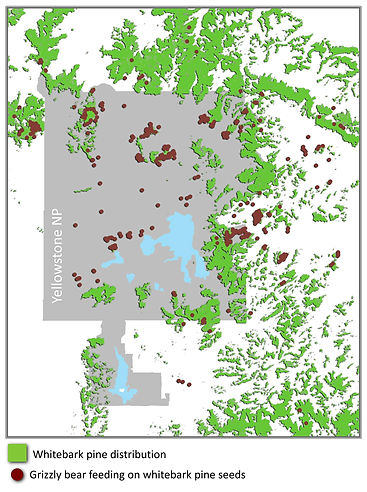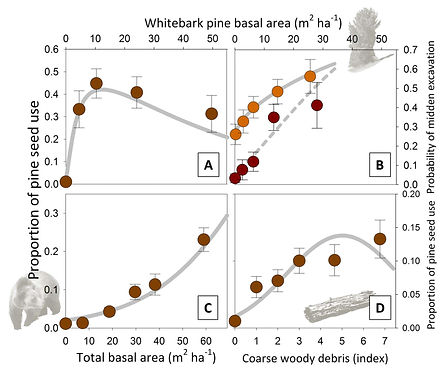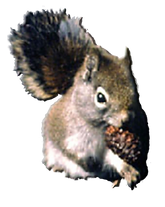
Mostly Natural
GRIZZLIES
Of the Northern Rocky Mountains
For everything on the politics and policy of grizzly bear conservation
go to Grizzly Times
For everything on the ecology of Ursus arctos, go to All Grizzly

Spatial Patterns of Grizzly Bear Feeding on Pine Seeds


As might be expected, grizzly bears do not feed on pine seeds independent of where whitebark pine occurs. But, subsidiary to the obvious, the details of spatial associations between bear feeding and whitebark pine turn out to be quite complicated, largely because of the extent to which grizzly bears depend on red squirrels for access to pine seeds. As I describe in the Introduction, around 93% of the documented instances where grizzlies fed on pine seeds in the Yellowstone ecosystem involved raiding cone caches made by squirrels. Which means that much of the explanation for spatial patterns of bear foraging on pine seeds end up being explained in terms of squirrel ecology.

Distribution of Bear Feeding in Yellowstone
An introduction to spatial complexities comes simply from examining a map of documented instances where grizzly bears fed on pine seeds in the Yellowstone ecosystem, 1975-1996, relative to a commonly used representation of whitebark pine distribution for this region--as shown in the map at left. The basic point is that most of the sites where bears fed on pine seeds occurred outside the mapped distribution of whitebark pine. In fact, fully 58% did. Even allowing for an unlikely systematic tendency for field crews to plot feeding activity erroneously outside, rather than inside, mapped whitebark pine distribution, 32% of all feeding-sites occurred more 300 m outside of a boundary.
Obviously, mature cone-producing whitebark pine did occur at each of the documented feeding sites, otherwise there would have been no pine seeds for the bears to eat. But, typically, whitebark pine was a minor component of the overstory. The implication is that those who mapped the distribution of whitebark pine were biased towards areas where the species was an abundant and easily-observed part of the overstory, and against typically lower-elevation sites where it was less common. Yet, these lower-elevation mixed-species forest stands turn out to be the most heavily-used of all by bears for feeding on pine seeds.
Parenthetically, whitebark pine occurs only at the highest elevations of the mountain ecosystems that it occupies, up to and including timberline. In the Yellowstone ecosystem, that means that most whitebark pine occurs above 7800' in the north, grading to 8400' in the south.

Further evidence of the importance of whitebark pine in lower-elevation mixed-species forest stands comes from looking at the odds that bears would have fed on pine seeds, versus not, as a function of forest stand characteristics using data collected by following radio-marked bears around and observing what they were doing.
Figure A, at right, shows odds of pine seed feeding (y-axis) as a function of increasing amounts of whitebark pine (as basal area; x-axis). Rather than steadily increasing as amounts of whitebark pine increase, odds instead peak at a relatively low abundance, around 5-30 m2 per hectare, which seems counter-intuitive. However, you do see steadily increasing odds of pine seed feeding with increasing amounts of mature trees of all species, as shown in C. Which also seems odd. Why would bear feeding track total stand basal area rather than, more simply, basal area of whitebark pine?
Bear Feeding Relative to Stand Characteristics
As I previewed earlier, the answer has to do with squirrels. It turns out that red squirrels are consistently more numerous in stands with abundant but diverse overstory trees. By contrast, squirrels do poorly in monocultures, especially of whitebark pine, which occur only in harsh environments at the highest elevations. Diverse overstories translate into a more consistent food supply for squirrels, one year to the next, because individual tree species tend to produce cones on a boom-bust cycle. So more trees of different species means a more consistent and abundant food supply, which results in consistently higher densities of not only squirrels, but also middens within which they cache whitebark pine cones later exploited by bears.
The tie of bear foraging to squirrel middens is further indicated by the relationship shown in figure D, above, between odds of bear feeding and abundance of deadfall (i.e., coarse woody debris; x-axis). Squirrels like to locate their middens in and around deadfall, but only up to a point, which yields the hump-shaped relationship in D. In other words, the relationship between deadfall and bear foraging on pine seeds is an artifact of the relationship between squirrels and deadfall.
To get a direct linear relationship between whitebark pine abundance and grizzly bear foraging on pine seeds, you end up needing to look at bear feeding in terms of odds that a given midden will have been exploited--in other words, on a per midden basis, not a unit area basis. Such a relationship is shown in B, above, using data collected along transects in two different study areas, the data from each denoted by different colored dots. As whitebark pine basal area increased from 0 to 35 m2 per hectare, odds that a given midden was exploited by bears steadily increased, concurrent with declines in unit area densities of middens and bear feeding. Purer stands of whitebark pine supported fewer middens, but each of these middens was more likely to be used by a bear.
Squirrels and Forest Characteristics


The figure immediately above reiterates some of the points I made earlier about habitat relations of red squirrels, featuring densities of active squirrel middens on the y-axis in all three graphs. In A, each of the bars correspond in height to the density of active squirrel middens in different habitat types, with the different-colored bars representing data collected from two different study area. WBP denotes whitebark pine; LPP, lodgepole pine; Abla, subalpine fir (Abies lasiocarpa); Vagal, globe huckleberry, an understory shrub; and Spbe, spirea, also an understory shrub. The WBP type represents the harshest environments where whitebark pine dominates, and the last two types the lowest-elevation sites commonly supporting whitebark pine.
The basic point of graphs A and B is that active middens are least dense on the harshest sites, whether the highest elevation sites with the most abundant whitebark pine (WBP and WBP/LPP types) or the lowest-elevation driest sites typified by an understory of spirea (Abla/Spbe). By contrast, midden densities are highest where there are significant admixtures of especially lodgepole pine (B). Graph C simply shows that densities of middens excavated by bears to feed on pine seeds track densities of active middens, which is my main point throughout, and the key to untangling an otherwise obscure relationship between whitebark pine trees and bear feeding on seeds.
The Midden Game


The last piece of the puzzle of spatial relations between bears and whitebark pine plays out at the finest scale of individual middens. Simply put, bears are more likely to exploit big middens rather than small ones, which is shown in figure B, at left, again using data collected along transects in two different study areas. The reason is illustrated in figure A, which shows the number of cones excavated by bears from an exploited midden (y-axis) relative to midden size (as length x width; x-axis). Larger middens yield more cones, which yield more seeds, which predictably make for greater efficiencies, which result in greater odds of bear use.
Figure C, at bottom, above, shows average size of middens reckoned for the same habitat types used in the figure immediately above. Middens are largest by far in the LPP/WBP and WBP/LPP habitat types, which also support relatively high densities of squirrels, resulting in these types being consistently the most heavily exploited of all by Yellowstone grizzly bears. At the other extreme, not only are squirrel densities low in the harsh environments of WBP stands, but middens here are also the smallest. Put together, minimal use of these high-elevation whitebark pine stands by bears is predictable. And, yet, returning to my beginning point, these sorts of stands are perhaps the easiest and most likely to be included in any map of whitebark pine distribution.
Refuge Effects


The final important spatial relation between bears and whitebark pertains to relations, in turn, between people and bears. This latter relationship is critical because people kill between 70 and 90% of all bears older than cubs and yearlings, and much of this human-caused mortality is driven by exposure of bears to people. All else equal, the greater the exposure, the more bears die (see this entry on human lethality).
The figure above portrays critical features of whitebark pine x grizzly bear x human relations in Yellowstone, differentiated by years when we had poor pine seeds crops versus good ones. As elaborated in the section on Temporal variations, crops do vary widely one year to next, with effects on where bears are on the landscape relative to places where people concentrate--along roads and in developed areas with permanent or transient housing. The bright green line with dots shows the relative abundance of whitebark pine as one moves from left to right progressively farther away from roads and developments. Whitebark abundance progressively increases quite simply because this pine is a denizen of the highest elevations, whereas most human facilities are located in comparative lowlands.
The dark green line portrays the relative distributions of grizzlies during years when seed crops were good which, not surprisingly, was strongly positively correlated with distributions of whitebark pine. As a result, when crops were good, bears tended concentrate far away from most people and, because of that, survived at a higher rate (see Demography). By contrast, the gray lines show the characteristic distributions of grizzly bears during years of poor seeds crops. The pattern was reversed, with especially juveniles and females with dependent young tending to concentrate near people. As a result, bears died at much higher rates, primarily because of more frequent conflicts with people, historically often involving human-related foods such as garbage.
As an upshot, whitebark pine had a critical affect on the demography of Yellowstone's grizzly bears, primarily by affecting bears' distributions relative to people. Good seed crops lured grizzly bears into the de facto high-elevation refuge of whitebark pine forests. But because of catastrophic losses of whitebark pine to the direct and indirect effects of climate warming, this dynamic has faded into near-certain oblivion (see Temporal variations and Future prospects).

